


Our speakers on 8 November 2017 were Major Willem Steenkamp and the American military historian and author, Mr Terrence McGovern.
Major Steenkamp introduced his short introductory talk by explaining the strategic importance of South Africa and the Cape Sea Route to the East India Companies and the European powers from the 16th century onwards. While the East India companies have become history the importance of the Cape Sea Route remained crucial, even after the end of the Cold War It is still relevant today, especially with new threats to world peace.
He discussed the role of the coastal artillery in the defence of the Cape Peninsula in the period from the completion of the Castle of Good Hope in 1679 up to 1958 when the S.A. Naval coast artillery units were disbanded and the batteries placed in a state of care and maintenance with the arrival of the guided missile era.
He recalled the occasion when the firing of 2-and 3-pounder guns shattered windows at the Castle at the start of a military tattoo.
Our main speaker, Mr Terrence McGovern, the American military historian, author and member of the American Coast Defence Study Group Inc., then took over. This is a tax-exempt corporation dedicated to the study of coastal fortifications round the American coastline. He was on a visit to South Africa with a fellow member of his group, Mr Glen Williford, also an author and historian. They are touring our coastal defences on a tour led by Capt Chris Dooner SAN (rtd). Mr McGovern first traced the history of coastal artillery in the USA and showed us what the surviving batteries look like today. He discussed the role of the colonial powers - Holland, Spain, France and Great Britain - in the development of America’s seacoast defences from 1794 to 1808, using an excellent power point presentation.

Fort Monroe, Hampton, VA
America has a very long coastline and had a relatively small population during the colonial period. Building coastal defences was expensive and took time but, once they were completed, they served their purpose and discouraged would-be attackers. The type of building material changed over the years from stone and brick to concrete and reinforced steel.
Our speaker explained that very few of the forts from the post-independence era have survived and showed us photographs of Fort Monroe, Fort Delaware and Proctor’s Tower – the latter now slowly sinking into the Gulf of Mexico. During the American Civil War of 1860 to 1865 steam-powered ships carrying heavier guns, were introduced. This had an effect on the type of defences built.
The addition of the Philippines and Hawaii to the territory of the United States required the construction of suitable defences to protect these newly-acquired territories.
In 1885 the Endicott Board carried out the first major review of American defences and for many years afterwards the US Army attempted to provide all the guns and installations recommended by this Board. In 1906 modifications were made to the Endicott Board report by the Taft Board.
Although fortifications were being constructed and armed, changing strategic requirements were largely ignored. The US Ordnance Department was responsible for ordnance design and operation. It was only when Major General Crozier, Chief of Ordnance, resigned in 1918 that some types of mounting which had long been replaced in other countries could be replaced in the USA.
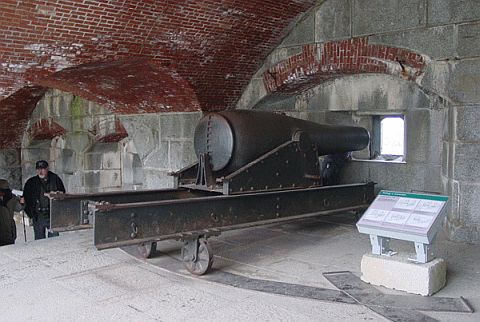
Gun in casemate at Fort Knox, ME
American sea coast mortars, which were really short barrelled 12 inch breech-loading guns, were introduced in the 1880’s. These were concealed in pits which hid them from the ships which were their targets. The mortars were mounted on turntables so as to command a wide arc and were used in batches of sixteen. Several hundred of these mortars were emplaced in the United States and its dependencies. Initially the object was to fire all sixteen mortars at once but this became unnecessary with the introduction of improved fire control and position finding. Severe blast damage and the adverse effect of such salvos on the gunners resulted in the mortars being fired electrically.
Another problem occurred when the gun detachments came out to load and relay their mortars after firing, which resulted in considerable congestion in the gun lines. A shortage of coast gunners in the early 20th century resulted in only two mortars in a pit being manned for practice shoots. A fortunate result of this resulted in an improvement in the rate of fire and the pits thereafter contained two mortars only.
Many mortars were mounted on railway trucks during World War One and many of these were never returned to the United States in 1918. Others became obsolete when they were outranged by more modern battleship guns and the rest were kept in areas which commanded restricted waters. These were used to good effect in the Philippines during World War Two.
Mr McGovern next discussed the American disappearing guns which remained in use long after they should have been replaced because of financial constraints. The calibres of these guns were 6-, 8-, 14-and 16-inch guns. By 1939, the 6-inch guns in the USA included a large variety of ordnance some of which was on disappearing carriages. Lack of elevation was a huge disadvantage. The American disappearing carriage had been designed by General William Buffington-Crozier who was Chief of Ordnance and who opposed the introduction of Barbette designs.
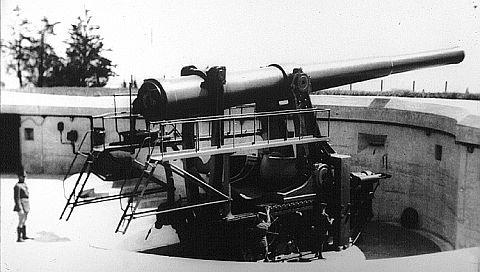
The 14-inch disappearing gun of Battery Osgood, Fort MacArthur, Los Angeles, CA
Railway guns were used by the United States Forces in both World Wars. The advantage of these was that they could be redeployed quickly to wherever they were needed and did not cause congestion on the roads.
After World War One the Americans copied the German Army and used Railway Guns as mobile Coast Artillery weapons. Budget cutbacks made it impossible to build railway gun emplacements before World War Two and other priorities for funds and personnel greatly limited their use when hostilities started.
Our speaker then discussed the use of mine planters, controlled minefields, searchlights and radar which were all used in coastal protection along America’s coastline during World War Two.
He next showed us slides depicting the present state of the surviving American coastal artillery installations. These range from some in excellent condition, others converted to different uses and ones which contractors had unsuccessfully attempted to demolish, bankrupting themselves in the process.
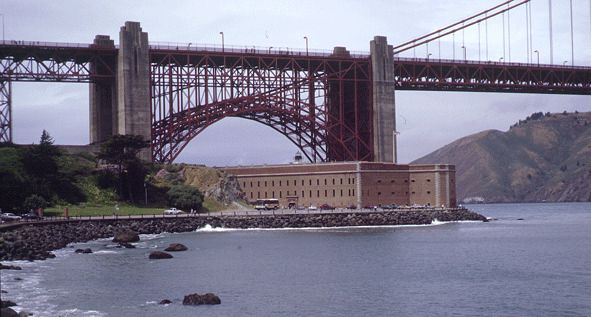
Fort Point, San Francisco, CA
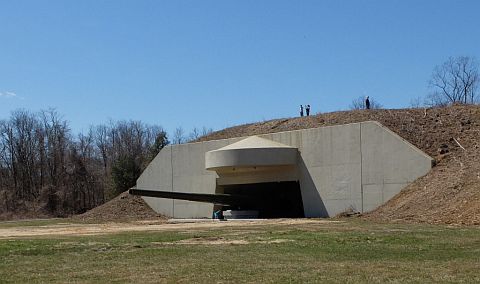
Restoration: 16-inch/50 barrel placed in the gun house of Battery Lewis, Navasink, NJ
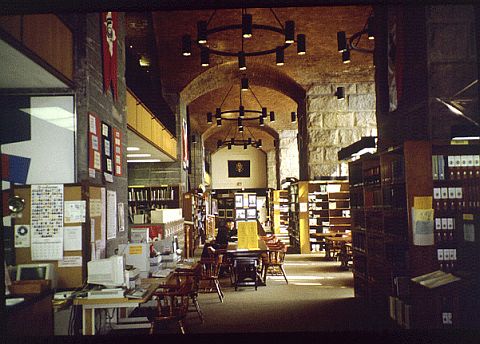
Re-utilisation: Library in casemate of Fort Schuyler, National Maritime Academy, NY
Mr McGovern explained that the Coastal Defence Study Group was founded in 1985 at Fort Monroe, Washington, and was incorporated in 1993. Their website is http://adsg.org. They hold conferences, organise tours and publish books.
This excellent lecture on a subject unknown to our members elicited many questions and much discussion ensued afterwards from the audience present.
Capt Chris Doomer, SAN (Rtd), thanked Mr McGovern for providing us with this fascinating and unexpected treat and praised him and his colleagues for their pioneering work in preserving America’s coastal artillery heritage before presenting him with two books on South African coastal defences on behalf of the SAMHS.
MEMBERS
The committee trust that all members had a well-deserved and joyous festive season and want to wish everyone – along with their family members – a wonderful 2018. We are looking forward to see you at our regular meetings scheduled for this year.
FORTHCOMING MEETINGS
THURSDAY, 18 JANUARY 2018: CASSINGA REVISITED by Jim Harwood
On May 4th, 2018 (08h00), it will be 40 years on from the SADF attack on the camp/town of Cassinga, 250 km into Angola, when an aircraft bombing attack was launched and 367 Paratroopers dropped in soon thereafter.
Political, Military, Academic and (let’s call it) Social controversy/interest has raged in varying degrees of intensity ever since:
• "It was a 'Refugee' camp and 700-odd innocents were slaughtered".
• SWAPO's version of events hit the world headlines first and the South African Government was thereafter on a hiding to nothing and almost a non-starter in the propaganda war that followed.
• The SWAPO/PLAN Commander in Chief Dimo Amaambo was reputed to have high-tailed it out of Cassinga at speed before the ground attack could be properly initiated - he was obviously an exponent of the old Guerrilla adage: "He who survives and runs away...." (or words to that effect).
• Only after the event was everyone made aware of the fact that the scale of the photograph used for the planning was wrong and the Drop Zones were in fact only half the size envisaged. This led to all sorts of grouping problems, especially with the Assault Company effectively being halved as a result of the number of them landing on the wrong side of the fast-flowing Colui River.
• The ground assault got bogged down due to the confrontation with the "Refugees" shooting from well-placed trenches and a few 14.5mm KPV machine guns. (Rumour has it that the latter were manned [sic "womanned"?] by a constant stream of a strangely disenchanted/dissident group of SWAPO. Factional infighting of SWAPO thus ironically turned out to be their best defence against us.) The target was eventually taken approximately 5 hours after the initial bombardment, but only after heavy, and sometimes hand-to-hand, fighting.
• The Cuban allies (an Armoured force stationed at Techumatete 25km away) bravely came to the rescue once they thought the helicopters had extracted the SADF troops. Little did they know that the SAAF only had enough helicopters to extract half the assault force and that some of the rest were still waiting for them in an ambush position. A (very) "hot extraction" ensued and (through Divine Intervention of that there is no doubt) the rest of us left Cassinga unscathed. This other "intervention" was by two of our SAAF Mirages and a Buccaneer all whose timing of arrival could not have been better. They happily added a few Cuban tanks and BTRs to their tally.
• The SADF lost 4 KIA and 1 MIA. There remains vast speculation as to SWAPO deaths and, no doubt, the truth will never come out. 700 combatants seems to be close to the "official" figure but a figure as high as 1,200 has been mooted too and at least 200 of the" intervening" Cubans died.
• The MIA referred to above was a Paratrooper by the name of Skillie Human who was last seen exiting the plane. Recently the remains of someone possibly being those of Skillie has been unearthed and a "Bring Skillie home fund" has been launched in an attempt to get clarity (and closure for the family) on the matter. The process has however been bedevilled by speculation as to political fall-out that such a venture would cause in view of the SANDF's and SWAPO's "denial" stance in the matter. (Cassinga as a town has apparently been flattened in an endeavour to remove any unearthing of negative proof that it was in fact a military base.)
• Certainly a number of civilians were killed in the attack. They would have been casualties from the SAAF bombing and those caught in crossfire and could have been any of the town "locals", "comfort" ladies brought in for the soldiers and a busload of schoolchildren who, it was later heard, had been in their school bus that had been hijacked and used as "human shields" for self-defence purposes.
• It would appear as though Colonel Jan Breytenbach, the ground commander of the attack, had delayed for a number of years the writing of his book on the attack, but was prodded into finishing it when Colonel Mac Alexander, a Paratrooper Commander of a later vintage, acquired his Master's Degree with his thesis using the attack as his subject matter. So incensed was Jan Breytenbach as to Mac Alexander's negative "take" on a number of features of the attack, that he promptly finished his book Eagle Strike and took Mac Alexander to task on them. So too did Jan Breytenbach use the opportunity to lambast the “interference“ of Colonel du Plessis (his Commander who had “come along for the ride”) and caused confusion in the “chain of command”.
This is but the tip of the iceberg of what has been widely described as the “most successful Airborne Operation ever.”
BOB BUSER: Treasurer/Asst. Scribe
Phone: 021-689-1639 (Home)
Email: bobbuser@webafrica.org.za
RAY HATTINGH: Secretary
Phone: 021-592-1279 (Office)
Email: ray@saarp.net